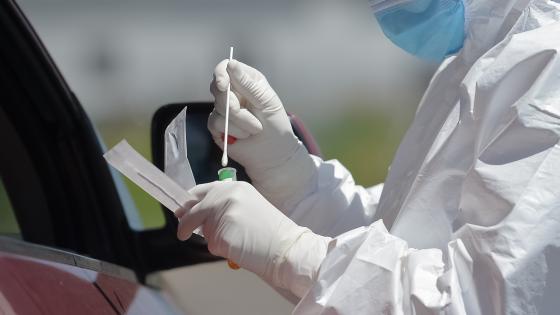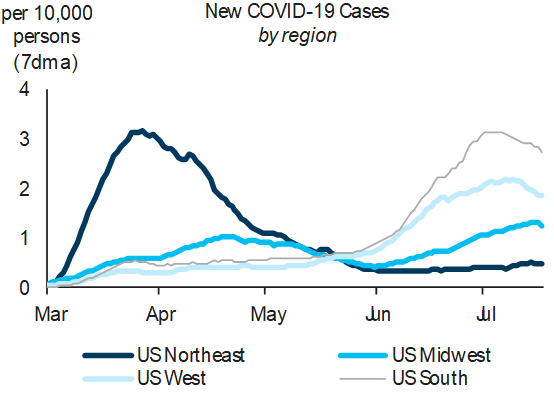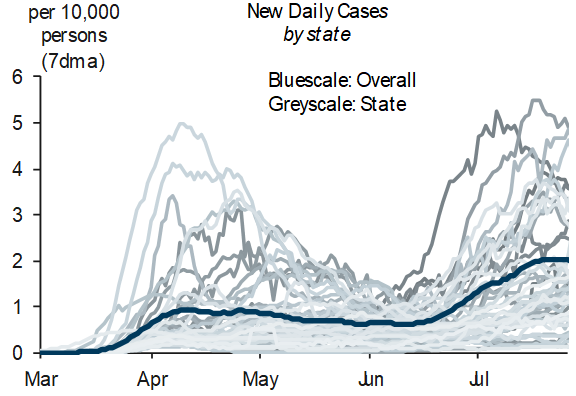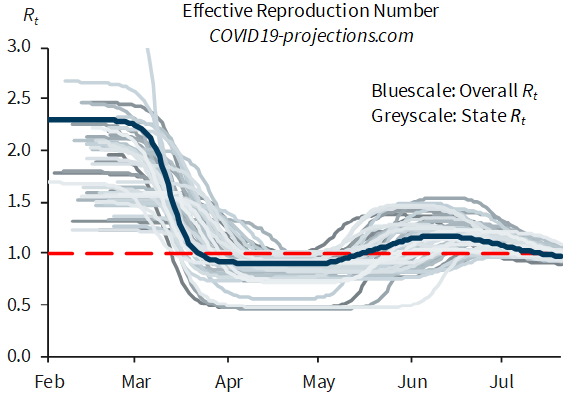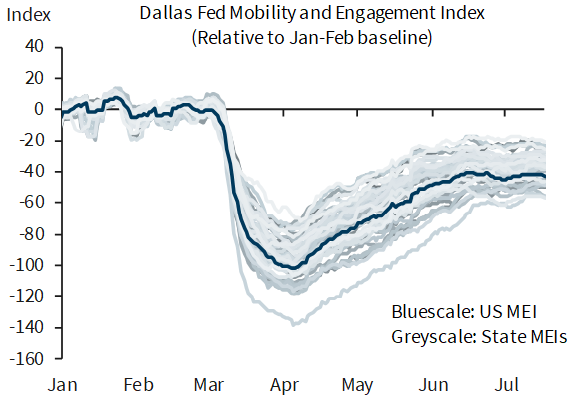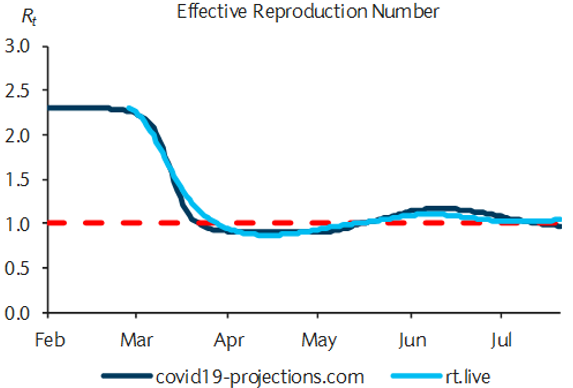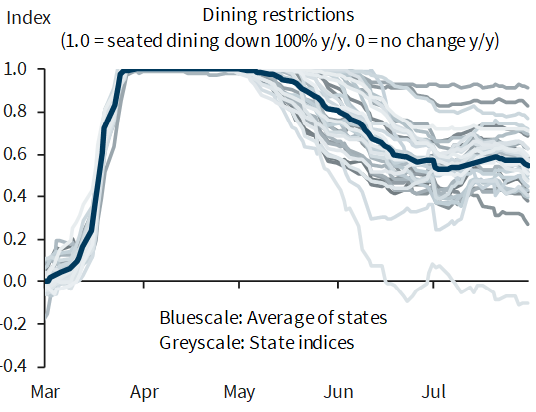With US activity having regained only some of the ground lost during the period of stay-at-home orders, experience resoundingly confirms that measures to slow COVID-19 – by governments and the public at large – have important ramifications for the macroeconomy (Lewis et al. 2020). Following sequential steps by many states to re-open non-essential activity in May and June 2020, a resurgence of new cases forced many states (including Florida, Texas, Arizona, and California) to pause – and even partially walk back – this process in late June and early July.
Although slowing down the pace of re-opening the economy helped put daily case counts on a downward trajectory (Figure 1), subsequent deterioration in high-frequency indicators, such as unemployment insurance claims, suggests that it is also slowing recovery. This puts policymakers at a crossroads as they consider measures that balance adverse health outcomes against forgone economic activity.
Figure 1 New case counts have turned downward, for now
Source: The COVID Tracking Project, Barclays Research
Figure 2 Personal mobility has fallen substantially in all states, including those that did not implement lockdowns
Source: The COVID Tracking Project, Barclays Research
Given these circumstances, evidence about the effectiveness of alternative remediation measures is useful, both to inform public policy and to assess implications for the economic outlook. To better understand the trade-offs, we use findings from our recent research (Gapen et al. 2020) to assess alternatives. These estimates exploit variation in remediation measures across a panel of the 50 US states (and Washington DC) from early February to late June 2020.
The effective reproduction number as a measure of contagion
To assess state-level public health outcomes, we use the estimated trajectory of the effective reproduction number, Rt. This choice is informed by epidemiology and provides a measure of the underlying pace of contagion that accounts for the role of herd immunity. We view Rt as ideal for our purposes because it succinctly summarises information about the likely evolution of infections in a given area, cutting through the noise inherent in positive-test counts and other measures.
The divergence between Rt and 1.0 is used as a benchmark to gauge the severity of contagion: sustained reductions in the infectious population require Rt to drop below 1.0, whereas values exceeding 1.0 indicate that active infections will grow. The size of the discrepancy informs us about the percentage change in active infections.
Based on an average infectious period of about 15 days, a sustained reading of 2.0 implies that the infectious population will double about every 10 days, while a reading of 1.1 implies doubling in 100 days. Working in the opposite direction, a sustained reading of 0.9 would halve active infections about every 100 days, while a reading of 0.5 halves them in 10 days.
This measure maps closely to the daily percentage change in new cases, which, in turn, maps to observed death rates after a lag of three or four weeks.
In practice, it takes a great deal of expertise to obtain reliable estimates of this number, in part because measured case counts are subject to noise from variations in testing and other factors. For this reason, we focus on estimates from COVID19-projections.com, which are generated using a machine-learning technique that seeks the best fit for the daily evolution of observed deaths, allowing for errors in case measurement. As documented on the website, forecasts using this methodology have outperformed other techniques during the outbreak.
As shown in Figure 3, estimated reproduction rates vary substantially across states and through time. The earliest estimates in late February had a central tendency somewhat above 2.0, ranging from nearly 4.0 in New York (not shown) to as low as 1.2 in Arizona and South Dakota.
Figure 3 Estimates of the effective reproduction rate vary substantially across states
Source: COVID19-projections.com
In principle, these early estimates are a good proxy for each state’s basic reproduction rate, which is what would prevail when the population is most susceptible, with no remediation. Variations in this rate across states reflect important conditioning factors such as population density and social preferences.
Despite this initial variation, the estimates tell a consistent story about the trajectory of the outbreak. Rt plunged below 1.0 through March and April in nearly all states, reflecting notable changes in private mobility (Figure 4) and stay-at-home orders in all but a few states. At that point, daily case counts for the US began to edge downward, consistent with the proximity of Rt to 1.0.
Figure 4 Personal mobility has fallen substantially in all states, including those that did not implement lockdowns
Notes: 7dma for the US and state-level MEI divided by 100. A value of -1 on the US index is equal to mobility observed during the week of April 11, 2020, when state-wide shutdowns were in effect. For regions with values of less than -1, mobility fell more than the national average.
Source: FRB Dallas, Barclays Research
As states relaxed restrictions on non-essential activity during May and early June, reproduction rates drifted upward, eventually exceeding 1.0 in most states by early June. From about mid-June onward, new cases began rising again, at varying rates, prompting some states to pause or even partially reverse re-opening, including Texas, Arizona, and California in late June and early July restricting indoor dining and bars. These measures have seemingly played a role in pushing down reproduction rates in recent weeks. The distribution of Rt across states is now fairly tightly bunched around 1.0, despite variations in mask mandates and other remediation.
While this is a positive development, it still implies that daily infections are poised to trend down only slightly, at best. Experience suggests that rates could re-ascend above 1.0 if states again relax restrictions. This narrative would not be much different if we had used alternative measures of the reproduction rate, such as from rt.live (Figure 5).
Figure 5 Alternative estimates of Rt tell a similar story
Note: Aggregate estimates for rt.live are formed by taking a population-weighted average across states. Source: COVID19-projections.com, rt.live, Barclays Research
What can we learn by comparing state-level experiences?
As we have noted, governmental responses to COVID-19 have varied widely. During the initial upsurge, 42 US states formally imposed stay-at-home orders, starting with California on 19 March, and several others imposed partial orders. The aggressiveness in easing these orders has also varied, with some states (such as Georgia) beginning by late April and others waiting until as late as 15 June (New Hampshire).
The aggressiveness of remediation has also varied, with substantial variation in mask mandates (as of 31 July, only 25 had state-wide mask requirements, with the rest having conditional requirements or recommendations) and in restrictions on restaurants and bars.1 Testing rates also vary widely across states and through time (Figure 6).
Figure 6 The overall US testing rate is gradually ascending, with wide variation across states
Source: COVID19-projections.com, Census Bureau, Barclays Research
But a key lesson from past months has been the significance of voluntary distancing, even when the policy approach has been more relaxed.2 This is evident when we compare personal mobility (Figure 4) and seated restaurant dining (Figure 7) across places and times with and without stay-at-home orders.
Figure 7 The pace of normalisation in seated dining has varied, reflecting aggressiveness of re-opening measures
Notes: 7dma in the y/y change in seated dining from OpenTable.com, divided by -100. A value of 1 is equivalent to no seated dining while values near 0 suggest a return to pre-COVID behaviour.
Source: Haver Analytics, Barclays Research
To be sure, these changes in behaviour peaked at the height of stay-at-home orders, suggesting that policy may have influenced distancing behaviour (and, perhaps, vice versa). Our estimates help to disentangle these two influences, suggesting that reductions in personal mobility, at their peak, reduced Rt by roughly half (45%), while stay-at-home orders reduced Rt by another 10% or so.
Even though personal mobility has risen throughout the country since April, it has remained substantially below pre-COVID-19 norms. While voluntary distancing has helped subdue COVID-19 reproduction rates as restrictions were eased, it continues to weigh on economic activity. Indeed, estimates of aggregate consumer spending through June show ongoing weakness in services sensitive to social distancing (including food services, air travel, and accommodation), even with government transfers boosting disposable income above pre-COVID-19 levels.
The persistent voluntary distancing indicates that policymakers cannot entirely prevent economic fallout from the virus. But it also hints at an opening for targeted mitigation measures aimed at boosting overall public confidence, which could make voluntary distancing less necessary.
This targeted approach would almost certainly involve more testing. As a benchmark, our estimates suggest that testing at a sustained rate of 1% of the population per day (about 3.3 million persons) is enough to reduce Rt by about 30%, roughly two-thirds of the reduction achieved from April’s peak-decline in mobility. With the US currently testing about 0.23% of the population per day (760,000 persons), this would roughly amount to quadrupling current test rates.
Granted, this scale of testing may be difficult to achieve in short order, in part because of limited supplies of testing materials. A reasonable near-term goal would be to boost testing to a sustained rate of 1.8 million persons per day (0.53%), which would be enough to reduce the Rt by nearly 18% and halve active infections about every 100 days.3
As testing capacity may be limited in the short term, other measures can function as an effective substitute. In particular, our estimates suggest that the reduction in Rt from mandatory state-wide mask requirements is roughly equivalent to testing 0.31% of the population per day.4 For states reluctant to impose such a mandate, we also find evidence that a prohibition on in-person restaurant dining can serve as a somewhat less effective substitute.
Although the state-level experience also suggests that herd immunity will gradually diminish the need for remediation over time, the effects become meaningful only after much of the population has been exposed. Specifically, for each percentage point of the cumulative number of positive tests as a share of the population, we find that the Rt declines by about 5%. At present, with positive tests amounting to about 1.4% of the population, the implied reduction in Rt is only about 7% – the same as testing 0.23% of the population per day. Hence, the US will likely need remediation for some time before herd immunity kicks in.
Figure 8 To date, positive case counts amount to nearly 1.4% of the overall US population and vary widely across states
Source: COVID19-projections.com, Census Bureau, Barclays Research
References
Abaluck, J, J Chevalier, N A Christakis, H Forman, E H Kaplan, A Ko and S H Vermund, (2020), “The case for universal cloth mask adoption and policies to increase the supply of medical masks for health workers”, COVID Economics 5.
Chernozhukov, V, H Kasahara and P Schrimpf (2020), “Causal impact of masks, policies, behaviour on early COVID-19 pandemic in the US”, COVID Economics 35.
Cleevely, M, D Susskind, D Vines, L Vines and S Wills (2020), “A workable strategy for COVID-19 testing: Stratified periodic testing rather than universal random testing”, COVID Economics 19.
Gapen, M, J Millar, P Sriram and B Uruçi (2020), “Assessing the effectiveness of alternative measures to slow the spread of COVID-19 in the US”, COVID Economics 40.
Goolsbee, A, and C Syverson (2020), “Fear, lockdown, and diversion: Comparing divers of pandemic economic decline in 2020”, NBER Working Paper 27423.
Lewis, D, K Mertens and J Stock (2020), “US economic activity during the early weeks of the SARS-Cov-2 outbreak”, COVID Economics 6.
Mitze, T, R Kosfeld, J Rode and K Wälde (2020), “Face masks considerably reduce COVID-19 cases in Germany: A synthetic control method approach”, COVID Economics 27.
Endnotes
1https://nga.org/wp-content/CoronavirusStateActionsChart_30July2020.xlsx
2 Similar behavioural shifts have also been noted by other research, including Goolsbee and Syverson (2020) and Chernozhukov et al. (2020).
3 Although we have no way to test its effectiveness, we recognise that policymakers could adapt a more strategic testing strategy that recognises limited resources, such as that laid out by Cleevely et al. (2020).
4 Our finding that mask usage effectively slows case growth complements econometric evidence from Abaluck et al. (2020), who used a 42-country panel, and Mitze et al. (2020), who used regional variation in the timing of mask-wearing requirements in Germany.
